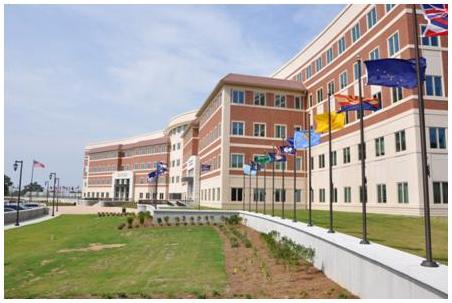
Occupying more than 251 square miles and covering parts of four counties (Cumberland, Harnett, Hoke and Moore) in southeastern North Carolina, Fort Bragg is one of the largest military complexes in the world. Recent BRAC-related construction there includes a new LEED-Gold certified headquarters for the U.S. Army Reserve Command (USARC) and the U.S. Army Forces Command (FORSCOM), both of which relocated from Fort McPherson, Georgia (near Atlanta) in a multiphase move that took place between October 2010 and August 2011. Fort Bragg also is home to the XVIII Airborne Corps, U.S. Army Special Operations Command, the 82nd Airborne Division, Joint Special Operations Command, Simmons Army Airfield and Pope Field. (The 7th Special Forces Group relocated from Fort Bragg to Eglin Air Force Base in Florida as a result of BRAC.)
Named for native North Carolinian and Confederate General Braxton Bragg, the base began its existence as Camp Bragg, a training and weapons testing facility, on September 4, 1918. After it was almost closed because of postwar budget cutbacks in 1921, it became a permanent Army post and was renamed Fort Bragg on September 30, 1922. The Psychological Warfare Center (now known as U.S. Army Center for Special Warfare, some of whose more unusual activities inspired the book and movie, The Men Who Stare at Goats) was established there in 1952. Today, Fort Bragg is home to approximately 57,000 military personnel, 11,000 civilian employees and 23,000 family members.
BRAC 2005 added two major commands to Fort Bragg, FORSCOM and USARC. They moved a total of about 2,900 workers from two separate headquarters buildings in Georgia into the new $302 million, four-building, 631,000-square-foot shared headquarters complex, which eventually may house as many as 3,085 people. (The facility was turned over to the U.S. Army on June 20, 2011, one day ahead of the scheduled contract completion date.) In addition to the FORSCOM/USARC headquarters, Fort Bragg has six other LEED certified buildings. Two maintenance shops and a renovated 1930s-era quartermaster building have been certified LEED-Silver; a training support center and a disaster recovery center are LEED Gold; and the $2.6 million, 8,300-square-foot Community Emergency Service Station completed in March 2011 has been designated LEED-Platinum.
Looking beyond BRAC, Fort Bragg will continue to grow, primarily on a 600-acre “bulge” that juts into Fayetteville and once housed an ammunition dump. “Patriot Point” (so-named because part of it is occupied by a Patriot missile–armed unit) is Fort Bragg’s last large tract of undeveloped land not subject to environmental restrictions. The military is spending millions of dollars building roads, utilities, offices, barracks and motor pools there, much of which will be used by growing special operations units, including the 3rd Special Forces group. (The total cost of all planned construction is about $370 million.) This could lead to an even bigger boom if, as expected, the growth on Fort Bragg is mirrored by civilian development just to the south on one of Fayetteville’s largest empty tracts.
